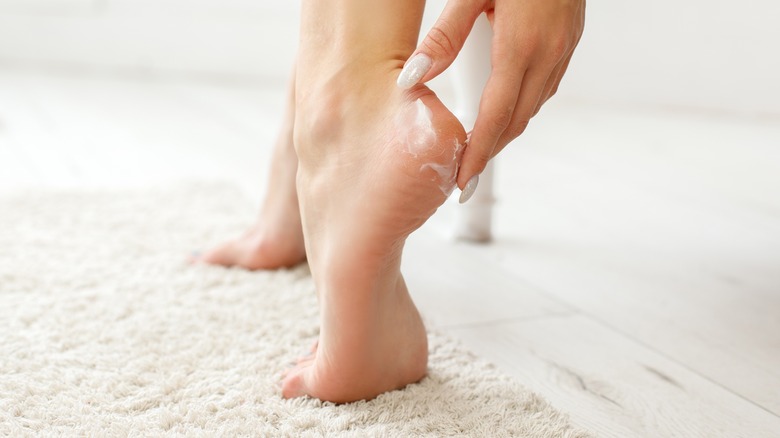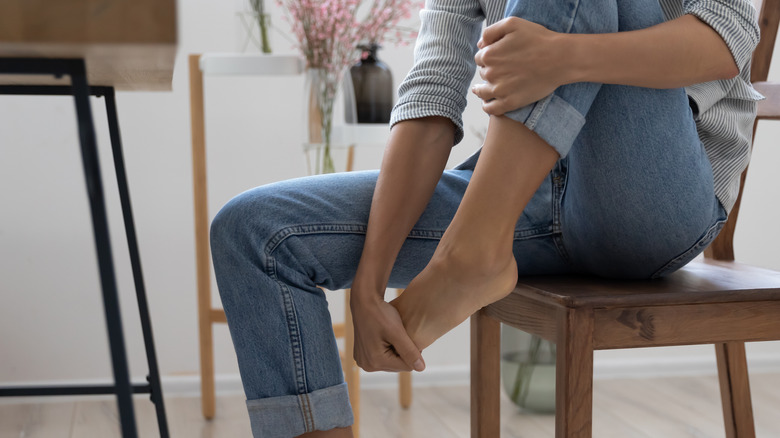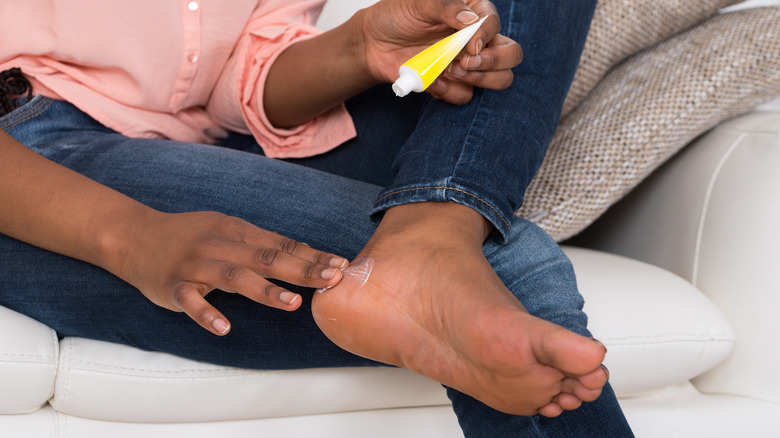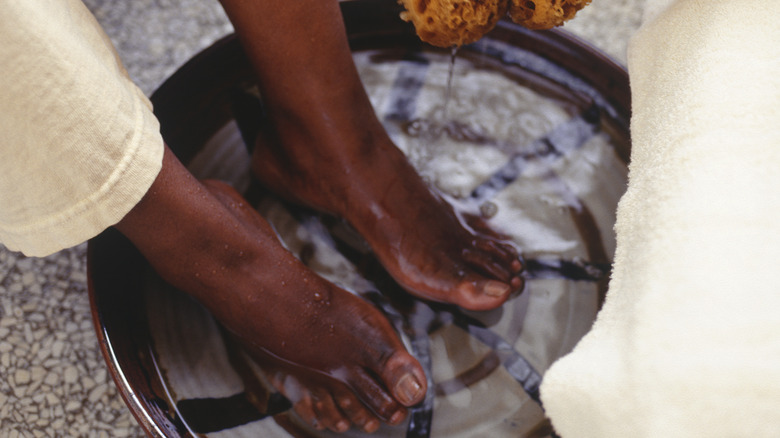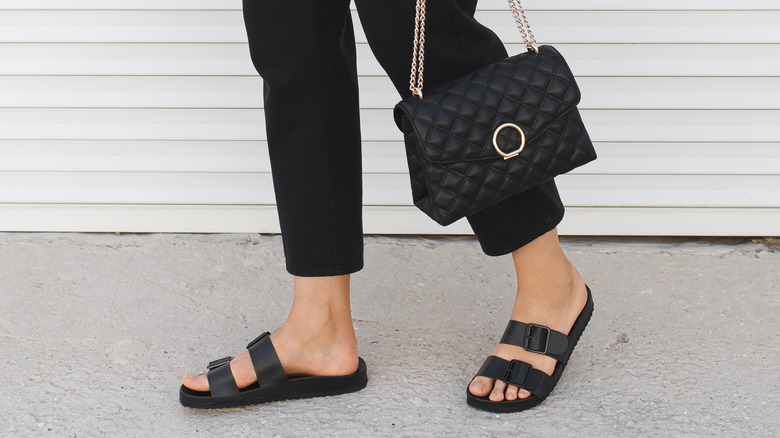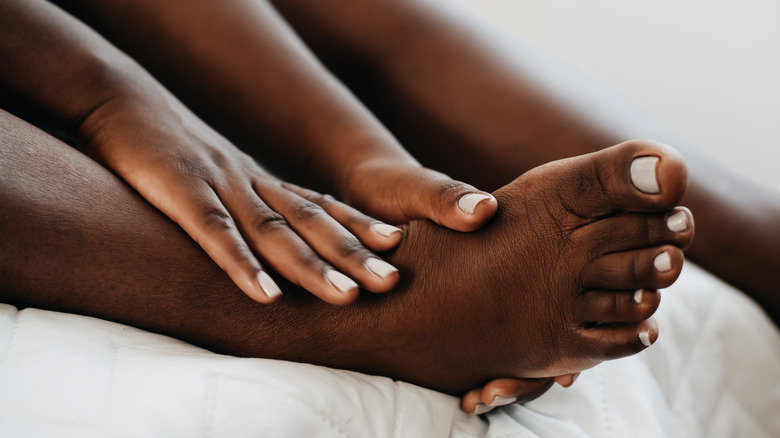Our Best Tips For Treating & Preventing Cracked Heels
Dry, cracked heels are a pretty common problem. In fact, as many as 20% of people in the US aged 21 and older have, at one time, had cracked skin on their feet. That's as many as 44 million Americans, according to the 2012 National Foot Health Assessment — that's a lot of people struggling with foot care.
As Lynn Mason, a nail expert for Mavala, told Glamour, a lot of the time, cracked heels develop when the skin on the foot hasn't been properly moisturized. That dry skin can then be exasperated by everyday factors like poor footwear or a lot of prolonged standing and moving. But just because it's not a particularly rare occurrence to have dry, flaky foot skin, that doesn't mean it's not painful. Cracked foot skin can be seriously uncomfortable and can hinder day-to-day life, as those suffering may notice swelling, itchiness, and flaky skin. Not to mention, the most dramatic cases can be a magnet for infection and may even bleed. There's also the less serious but still distressing cosmetic aspect, as many people choose to avoid certain types of shoes in an attempt to cover up or not hinder their cracked skin.
Luckily though, the issue can easily be treated and prevented, and we've rounded up some of the very best expert tips and tricks that'll have you saying sayonara to unsightly heel cracks in no time.
Stay off your feet (as much as you can)
One of the reasons you may be experiencing cracked heels is that you've been spending too much time on your feet. Of course, it's not healthy for us to be sitting around all day and it's super important for your body's overall health to get up and move (WHO recommends an average of 60 minutes or more exercise a day), though long periods of time on your feet may be to blame for foot dryness. Particularly if you spend a lot of time walking around or standing on hard floors for things like work or exercise.
One way to prevent standing from having too much of an impact on your feet is to take regular breaks where you're off your feet. You could also, when possible, try and change up the terrain you're walking and standing on. If exercising on a concrete floor is mainly to blame for your cracked heels, try getting your workout in on softer ground, like grass or a padded gym floor.
Keep those heels moisturized!
Of course, one of the main ways to avoid cracked heels is to keep the area properly moisturized. This alone can greatly decrease your chances of getting dry skin on the feet which can lead to serious health issues. Lynn Mason recommended applying a moisturizing foot cream twice a day, both in the morning and at night, focusing on the heels if you're particularly prone to dryness (per Glamour ). Andrew Gladstone, podiatrist, MCRPod, and founder of City Chiropody, also gave some expert advice, sharing, "Use a good moisturizer at least once a day that contains urea which is a gentle chemical skin softener and is great at hydrating the skin rapidly." Moisturizers containing lactic acid, salicylic acid, alpha-hydroxy acid, and saccharide isomerate are also recommended by WebMD. After applying your moisturizer, you can even try wearing a pair of socks to keep the product on your feet longer.
In addition to a good, moisturizing foot cream, ensure you're using the right products before you turn to body lotions. That's because things like the wrong body washes can actually dry the skin out more. "Harsh soaps can break down your natural skin barrier, so switch to a non-fragranced, moisturizing liquid cleanser to help," board-certified dermatologist Dr. William Huang told NBC Select.
But make sure you're taking care of your feet more generally, too
It's not just regular moisturizing that you should be focusing on to beat those cracked heels, though. Taking care of your feet by getting regular pedicures can also help eliminate all that dry skin, because a professional will remove the dead skin before it has the chance to develop into painful cracked heels. This will keep your feet looking and feeling healthy.
But this upkeep can also be practiced at home if regular pedicures just aren't an option for you (we know, it can get pretty pricey). It's important if you're prone to cracked heels that you use a foot file to buff away the dead skin that can cause serious side effects. "Use a foot file twice a week and be careful not to over-file," podiatrist Margaret Dabbs recommended to Grazia UK. Removing the dead skin can actually help your foot creams penetrate the skin more effectively, which is why you should always apply your moisturizer afterward to help keep the dryness at bay.
It's only recommended you buff away the skin yourself though if your heels are not yet cracked. If you're noticing cracks or any of the symptoms that come with them (such as bleeding or an infection) or it feels painful to buff away the skin yourself, it's important to seek advice from your doctor or podiatrist to make sure the issue doesn't get worse.
Make sure you have appropriate footwear
Another reason you may have noticed your heels looking cracked is improper footwear. Though what counts as proper and improper shoes differs from person to person and their daily activities, in general, wearing shoes without a whole lot of support on a regular basis can actually lead to dry skin on the heels. That can include things like slingback shoes and sandals, which don't offer much structure when you're walking or standing for long periods of time. To combat this, The Feet People's podiatrists recommend taking stock of your footwear needs and getting the most appropriate, supportive shoes available. If you do a lot of walking, for example, you'll want to ensure you have structured footwear to give your foot the proper support it needs. Your doctor may also be able to advise you on shoe inserts to help with the problem.
But it's not just a lack of support you have to think about when it comes to open shoes, "When we switch to wearing sandals, it may come as a surprise that the increased airflow around our feet can actually lead to dryness of the skin," Lynn Mason explained to Glamour. That's why you may want to keep your sandal-wearing to a minimum if you're particularly prone to heel cracks.
And protect your heels once they're cracked
If you already have cracked heels, it's imperative you don't walk around without protecting them. Carrying on as normal could make your cracked heels far worse, which is when bleeding and infections can arise. Instead, once you notice your heels are cracked, treat and protect them inside your shoes with something like a liquid bandage. As board-certified dermatologist Dr. Samer Jaber told NBC Select, "If you have painful cracks in your feet, a liquid Band-Aid can be very helpful to improve the pain and allow the area to heal."
But how do you create a liquid bandage? "Try filling the crack with antiseptic cream, like Savlon or Sudocrem, then covering the area with either a gauze and tape or a [Band-Aid]," Andrew Gladstone explained to Glamour. "Re-apply the [Band-Aid] and cream daily for a few days until it stops hurting. The cream and the [Band-Aid] will rapidly hydrate the skin and allow the edges of the crack to join together." Make sure you follow these instructions though and don't just put a normal Band-Aid on your heel to protect it. This can actually result in you pulling off the dry skin when you take off the Band-Aid, potentially leaving yourself open to infection.
If your cracked heels are severe though, consult your doctor. They may be able to prescribe medicine to help the issue, as well as advise on a specific treatment like skin glue or ointments.
